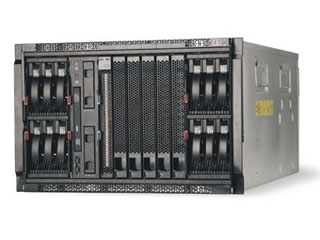EXCLUSIVE: IBM BladeCenter S
Blade servers are too noisy and impractical to have in the the office, right? IBM wants to change your thinking with the BladeCenter S series.


A very well specified blade server that'll give HP's BladeSystem c3000 a good run for its money. Remote management and monitoring capabilities come second to HP but for storage features and expansion the BladeCenter S offers some unique options.

Battle was joined in 2007 between HP and IBM for a slice of the burgeoning SMB blade server market and IBM struck first by announcing its BladeCenter S back in June. However, HP countered strongly by delivering its BladeSystem c3000, or 'Shorty', first to market in October, which we took an exclusive look at in the Business section of our sister title PC Pro. We now have the much-vaunted BladeCenter S and in another exclusive review we take a closer look to see what it has over HP's c3000.
With the BladeCenter S, IBM is primarily targeting the high growth small to medium business market and particularly those looking to consolidate and centralize their IT services. It also has its eye on large enterprises with geographically distributed locations such as branch offices and users where blade server technology has traditionally been too expensive or impractical due to size of the enclosures and operational noise levels.
Standing at 7U high the BladeCenter S is slightly taller than HP's c3000, which is a more compact 6U. Features that make this unique in the BladeCenter family are the dedicated areas for two storage blades and up to six server blades. The c3000 initially looks better on paper as it accepts four full-height or eight half-height blades or a mixture of both but the BladeCenter's storage facilities look a lot more versatile.
In the S chassis you have two dedicated blade slots at each end that accept IBM's storage modules. These each hold up to six 3.5in SAS or SATA hot-swap hard disks and connect directly into the chassis' midplane where they are placed in zones, enabling you to dish out storage to selected server blades. There are plenty of zone options and the review system came with a default configuration, which handed three drives in each storage module to the server blades in slots one and four. Other predefined zones are available or you can create custom ones and the server's embedded LSI Logic RAID controllers see their allotted storage as local.
Although storage blades for the smaller SFF hard disks aren't currently available IBM advised us it expects to support them later this year. Note also that the modules are not offering a shared storage solution as each drive can be mapped only to one server. The storage blades don't limit expansion potential as IBM's SAS Connectivity Modules can increase this massively. These slot into the rear expansion bays and offer four SAS ports to which you can direct attach IBM's external SAS disk arrays and external tape drives.
Get the ITPro daily newsletter
Sign up today and you will receive a free copy of our Future Focus 2025 report - the leading guidance on AI, cybersecurity and other IT challenges as per 700+ senior executives
Dave is an IT consultant and freelance journalist specialising in hands-on reviews of computer networking products covering all market sectors from small businesses to enterprises. Founder of Binary Testing Ltd – the UK’s premier independent network testing laboratory - Dave has over 45 years of experience in the IT industry.
Dave has produced many thousands of in-depth business networking product reviews from his lab which have been reproduced globally. Writing for ITPro and its sister title, PC Pro, he covers all areas of business IT infrastructure, including servers, storage, network security, data protection, cloud, infrastructure and services.
-
 Cleo attack victim list grows as Hertz confirms customer data stolen – and security experts say it won't be the last
Cleo attack victim list grows as Hertz confirms customer data stolen – and security experts say it won't be the lastNews Hertz has confirmed it suffered a data breach as a result of the Cleo zero-day vulnerability in late 2024, with the car rental giant warning that customer data was stolen.
By Ross Kelly Published
-
 Women show more team spirit when it comes to cybersecurity, yet they're still missing out on opportunities
Women show more team spirit when it comes to cybersecurity, yet they're still missing out on opportunitiesNews While they're more likely to believe that responsibility should be shared, women are less likely to get the necessary training
By Emma Woollacott Published
-
 OpenAI wants developers using its new GPT-4.1 models – but how do they compare to Claude and Gemini on coding tasks?
OpenAI wants developers using its new GPT-4.1 models – but how do they compare to Claude and Gemini on coding tasks?News OpenAI says its GPT-4.1 model family offers sizable improvements for coding, but tests show competitors still outperform it in key areas.
By Ross Kelly Published